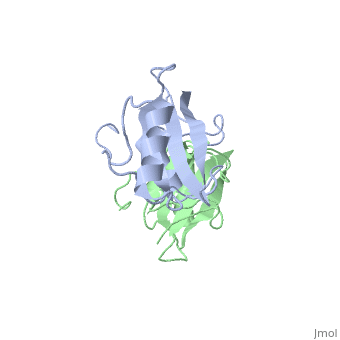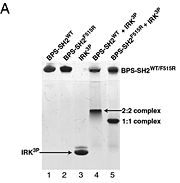Introduction
Grb10 (Growth factor Receptor-Binding protein) is a member of a family of adapter proteins (Grb7 and Grb14) that interacts with tyrosine kinases. [1]
Dimerization of the Grb10 SH2 Domain
The crystal structure of Grb10 SH2 (Src Homology) domain (molecular mass = 12.4 kDa) was an important step to understanding how this protein interacts with IGF1 receptors, and although the SH2 domain functions as an independent segment, it forms a dimer in physiological environments. [1] The exists due to the middle hydrophobic Phe515 and uncharged Thr504 (labeled blue) residues packed into its equivalent counter parter on the other protomer, designated as Phe515' and Thr504' (labeled red); Gln511 (blue) forms a hydrogen bond to the backbone of Asp514' (red) while the side chain of Asn519 forms two hydrogen bonds to the backbone of Lys505'. [1] The interface ends with Leu518 and Phe-496' via hydrophobic interactions. [1]. The structure of Grb10 SH2 forms similar SH2 domains found in other proteins, which have an on the outsides with anti-parallel .
To ensure the crystallographic structure of Grb10 SH2 is indeed a dimer in solution, Evan Stein and colleagues substituted Phe515 at the dimer interface with arginine (electrically charged side chain) and found, using gel filtration chromatography (Picture 1), that the Grb10 SH2 dimer had indeed become independent monomers.
Picture 1
The gel used for filtration chromatography had 5 lanes with 5 different components:
- BPS-SH2_WT (Wild Type)
- BPS-SH2_F515R (mutant = Phe515 --> Arg)
- IRK_3P (tris-phosphorylated Insulin Receptor Kinase domain)
- BPS-SH2_WT + IRK_3P
- BPS-SH2_F515R + IRK_3P
As seen in lanes 1 and 2, the BPS-SH2 proteins did not travel down the gel due to their high pI; to resolve this issue, the researchers added IRK_3P to the two BPS-SH2 proteins which then made a complex that was mobile. [1] Lane 4 shows a band labeled 2:2 complex that shows the position of the SH2 dimer. The additional band found at the very top of lane 4 represents the BPS-SH2_WT protein that did not complex with high motility protein IRK_3P, i.e. it was not able to migrate through the gel due to its high pI. Lane 5 shows a band labeled 1:1 complex elucidating that the Arg substitution at Phe515 did indeed produce a monomer, which was able to travel farther down the gel.
Why BPS-SH2?
In order for the full-length Grb10 protein to interact with Insulin Receptor Kinase (IRK), the SH2 and BPS domain must be present. [2]


